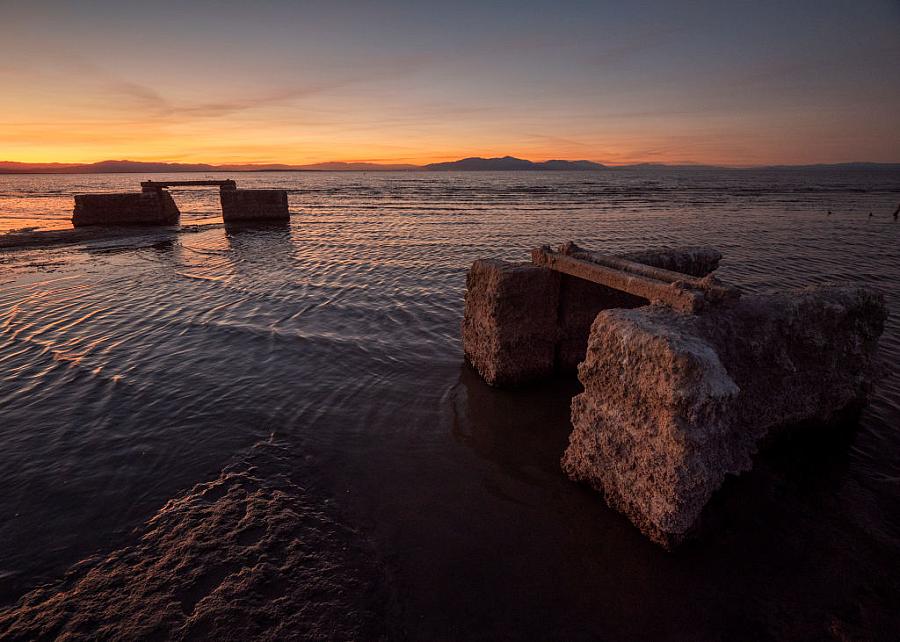At the shrinking Salton Sea, the lack of data is a big part of the health story

In 2022, while reporting on dust in the West, I found myself at the Salton Sea Summit in Palm Desert, California. The multiday meeting occurs every few years to discuss how to manage not only the shrinking Salton Sea, but the inevitable dust production that will result from the exposed lake bed. The region has a childhood asthma rate three times the national average.
The environmental fallout of the polluted, increasingly saline Salton Sea has largely focused on the wildlife impacts: the fish that died by the millions and the dozens of bird species that disappeared from California’s largest lake. But at the summit, I heard community members share their stories of childhood asthma, allergies, and nosebleeds with researchers and policymakers. The environmental justice implications, decades in the making, were clear — as was the limited effort to date to address them.
Several things struck me at the summit. Notably, everyone casually used the phrase “toxic dust.” It was clear there were many additional contaminants potentially in the sediment or dust — yet little research to either identify any particularly problematic agents or study the cumulative impact of so many toxins. The Salton Sea is full of metals such as selenium, pesticides, nutrients that fuel a near-constant algal bloom, and hydrogen sulfide odors. On top of that, smoke from agricultural burning and dust from the Anza-Borrego desert to the west contribute to high levels of particulate matter in the air.
The other dynamic that stood out at the summit was the lack of crosstalk between the various representatives from agencies, academia and community groups. This may be an unfolding environmental catastrophe, but each entity involved maintains only one sliver of oversight. And public health is among the lowest priorities. As UC Riverside geochemist Tim Lyons said in frustration in my story for Civil Eats, the disjointed Salton Sea deliberations are akin to a monster with 20 heads: “Half of those heads are eating each other and the other half aren’t talking to each other.”
Once I started working on this story, I did the usual search for research or public records on toxins in the sediment or dust. I combed through scientific publications, the closest EPA dust monitor data, CalEnviroScreen metrics for particulate matter, and other California state data records. The most recent comprehensive sampling for metals and pesticides was conducted in 2002. Despite calls for additional analyses of sediment and dust, they simply did not exist.
Sometimes, the lack of data is the key piece of the story. I decided the story needed to ask who should have been looking for specific toxins in the dust or sediment. The local air districts? The California Air Resources Board (CARB)? The Imperial Irrigation District? Public health agencies? I asked them all. Nobody claimed such measures were under their purview. Furthermore, they said, there was no funding for such expensive analyses.
I turned to a retired CARB staffer and Salton Sea residents to provide historical insights about agency oversight and how long these communities have been waiting for meaningful attention. In March 2022, as I prepared to attend the Salton Sea Summit, I first spoke to Earl Withycombe, then an air resource engineer at CARB who had worked for years at Salton Sea. He spent almost two hours with me, laying out the complicated, nuanced history and players involved in Salton Sea discussions.
When I began this story in earnest in early 2023, Withycombe was retired and willing to talk freely. He kindly spent several more hours with me. He described how he had nudged agencies to collect data on potential contaminants on sediment and dust over the years, with little success. He offered his perspectives on which agencies were doing a good job under tough circumstances, and which were being disingenuous at best.
Given the long, convoluted story of inaction on the Salton Sea — in a region where the agricultural industry has long held significant political power — Withycombe’s insights were crucial. I attended a number of webinars or online meetings about the Salton Sea over months of reporting. Whenever I asked a question about monitoring agricultural dust or practices, it was often met with deafening silence. Withycombe could — and would — make bold statements few others were in a position to do.
Perhaps most importantly, making connections with community members — including the promotoras who have partnered with academics to conduct participatory research to document and publish children’s health concerns around the sea — was key. The promotoras spent hours with me, describing what they’ve seen and documented over the years as well as their frustrations. They drove me to the neighborhoods enduring the greatest health impacts.
I also spent a Saturday morning in April 2023 with community scientists who use their free time to sample and analyze water chemistry and water quality to fill a gap left when the Bureau of Reclamation ceased taking measurements because the sea has shrunk so much that there are no functional boat ramps remaining.
Heading the advice of Center for Health Journalism California engagement editor, Cassandra Garibay, I created a Facebook group to share my findings and stories, and forge connections with community members who are active in ongoing management deliberations. Salton Sea residents continue to post pictures of dust storms to document the conditions.
I realized that a big piece of the story was how these communities, tired of being ignored, were creating their own data to fill the void of information and counter politicians’ claims that public health is being addressed.
One community advocate, Lillian Garcia, thanked me for highlighting their efforts rather than sticking to the usual agency talking heads. “Thank you for talking to the people who really matter,” she said. “Finally.”

